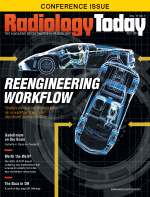 July 2016
July 2016
Editor's Note: Bias vs Context
By Dave Yeager
Radiology Today
Vol. 17 No. 7 P. 3
Removing bias from cancer screening guidelines is a worthy goal, but that shouldn't come at the expense of clinical context. As Kathy Hardy writes in this month's issue, that seems to be what happened when the US Preventive Services Task Force (USPSTF) developed its breast cancer screening guidelines. Since private insurance payers use these guidelines to determine reimbursement rates, ensuring that they reflect the most up-to-date clinical knowledge is imperative.
The draft recommendations for breast cancer screening that the USPSTF issued last year differed from the 2002 guidelines in that, rather than allowing yearly or biennial breast cancer screening for women aged 40 and older, they recommend biennial screening only for women aged 50 to 74. The task force cited overdiagnosis and anxiety from false positives as key factors in its decision. If this change is adopted, many women in the 40 to 49 age range may not be covered, and women in the 50 to 74 age range who prefer yearly screening may have to settle for biennial screening.
Although overdiagnosis and anxiety are issues, Hardy writes, earlier breast cancer screening saves lives. Because of strong opposition to the new guidelines, Congress enacted a two-year moratorium on their implementation at the end of last year; early screening advocates are hoping that the moratorium will allow enough time to gather evidence that will persuade the USPSTF to change its recommendations.
Considering that most doctors who perform breast screening are opposed to the guidelines, how did the USPSTF arrive at its conclusion? In an effort to reduce bias in setting the guidelines, the USPSTF does not include any radiologists or oncologists. That's one way to eliminate bias, but it has the unintended consequence of removing critical expertise from the process. For patients or doctors who are not well versed in the current screening literature, determining appropriate screening intervals can be confusing. As Hardy writes, the research behind screening protocols can be complex, and newer studies challenge some of the older ones that the task force consulted. In light of the clinical context that may have been overlooked in developing the new recommendations, perhaps it's best to keep the existing rules in place and allow women to decide whether the short-term anxiety of a false positive is worse than detecting an early-stage cancer when it's more likely to respond to treatment.
Enjoy the issue.

